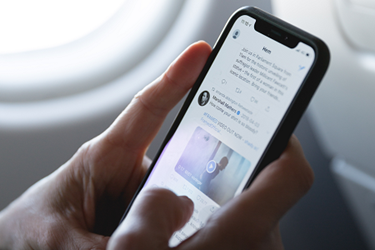Monitoring Adverse Event Reporting On Social Media — Should You Outsource?
By Rob Innes, Wyoming Interactive

“Adverse event reporting” and “Facebook” don’t really belong in the same sentence. Yet for many trial participants, Facebook (or another social network) is their go-to communication channel, slipping naturally into every facet of their lives. Unfortunately, this can be challenging for patients in a clinical trial, as social media features like immediate access and ease of use may not translate into effective communication for adverse events. For sponsors, CROs, and logistics partners, social media SOPs are needed (even if the route is discouraged) to best manage this challenge.
In my previous article, “Adverse Event Reporting On Social Media — What You Need To Know,” social alerts were considered as a patient choice for reporting adverse events during trials. Seasoned clinical trial professionals undoubtedly consider this a poor choice due to low visibility, difficult tracking, etc. However, social networks are embedded in the general public. As clinical trial professionals, we can encourage traditional reporting channels but we can no longer ignore social media.
For those administering trials (sponsors, CROs, or logistics providers) a simple SOP might look something like this:
Set up a monitoring environment to track instances of adverse events being reported. This would involve specialist software tools and detailed filters on social media channels. Each protocol will require different configuration, but, over time, learnings will emerge to speed up new protocol configuration.
Once the setup is complete, there is a constant loop of monitoring, filtering, escalation, action, and follow-up. The software tools scan constantly and issue alerts when “hits" are discovered. Manual searches are also supported (and recommended) which can discover alternative keywords, new abbreviations/slang, etc. to update the automated tool. Manual searches, especially in the early days of monitoring for a protocol, can give decision makers some comfort around the scale and reach of the process and help them understand what is and is not possible.
In the last article, top-level thoughts were shared on some of the challenges such as language cover (for trials spanning multiple countries) and emergency unblinding. Some challenges are difficult regardless of experience, such as customer identification due to private posts, non-obvious user handles, and partial or hidden user name settings. Some of these will simply fall out of scope for adverse event handling. However, some can be overcome through research, and some customers will welcome contact, particularly if they use “@drugcompany” in their post. Some challenges, such as language cover, specialist tools, and out-of-hours coverage, are specialties of outsource contact handling centers.
Using Specialist Outsource Handling Centers
Specialist outsource operations are third-party organizations that work for many brands, coordinating a large number of social media posts, telephone calls, and emails according to predefined SOPs using specialist technology.
For a large sponsor, it may make sense to have an in-house contact center, as the investment and operational costs can be amortized over a large number of trials and, in fact, across a wide range of business lines beyond trials. Some sponsors may elect to partner with a specialist contact center provider and outsource some or all of their contact handling.
In some sectors such as retail and entertainment, outsourced contact handling operations can be spun-up rapidly to service an expected peak in activity and then turned down (or off, even) once the promotion or sale is finished. Not so with clinical trials. The ramp-up with a handling center for clinical trials takes an extended period of time to allow for process development, training, and quality approval. For those running multiple trials, an initial investment in outsourced ramp-up is probably expected, but for small sponsors this may become burdensome. Sufficient time should be allowed to get the initial setup correct.
Outsourcers are used to integrating processes with clients so customers do not experience awkward handoffs between teams. However, clinical trials present some sector-specific processes that may be harder to manage. For example, escalation to a medical expert will always involve a handoff and require careful design, especially for out-of-hours coverage. So might emergency unblinding, a process unique to trials and requiring a high degree of oversight and data integration. Training can be extensive and may require company employees onsite to guide on acceptable language for social media posts, how to respond to different questions, etc.
Advantages of outsourcing to a specialist:
- process expertise in handling customer content
- familiarity of social media monitoring tools
- out-of-hours coverage
language cover - service platform resilience.
Potential disadvantages of outsourcing to a specialist:
- data access and privacy concerns
- potentially long ramp-up time
- escalation to in-house experts
- increased cost per contact
- training investment.
Selecting A Social Monitoring Outsource Provider
For many organizations, contact handling is not a core skill and should be placed with a trusted third party. Many sponsors find a specialist partner can provide service levels above what is achievable in-house. Below are some considerations for choosing the right one:
- Look for a partner with experience in fields closely related to your own and language cover to match trial profiles.
- Request case studies where similar challenges were encountered and overcome.
- Obtain references.
- Organize a representative trial — long enough to overcome initial onboarding challenges and to get sufficient confidence in the model.
- Invest in training — especially for the first trial, it’s best to over-invest in training.
- Consider sourcing team members to the outsource provider to build confidence for both parties.
- Test, measure, learn.
Building Social Handling In-House Capability
For other sponsors, adverse event reporting is too important to shift to an external partner, so in-house operation is the way to go:
- Get over the learning curve fast — invest in social media customer handling training.
- Run tests with candidate software tools for social media monitoring.
- Engage with peer groups — former colleagues, industry associations, and business seminars for tips on process and tools.
- Develop a solid process for identifying risks and escalating through the organization to medical experts.
- Establish a ring-fence monitoring team (at least until initial trials demonstrate likely resource needs).
- Develop a recording method (a system is preferred over paper) to track “hits” and demonstrate process steps taken.
- Consider supplementing in-house teams with external expertise to get started.
- Test, measure, learn.
Despite the trials of onboarding an outsource partner or the internal adjustments necessary to integrate in-house capability, it’s clear this challenge needs to be addressed. The ubiquitous nature of mobile devices means mining and monitoring social media channels and managing the challenges associated with them through technology, process management, and tactical outsourcing need to be considered standard operating procedure for clinical trials professionals and organizations.
 About The Author:
About The Author:
Rob Innes is head of consultancy at Wyoming Interactive. In this role, he manages consulting engagements for the firm’s life sciences clients, helping to drive business transformation in response to industry challenges.
Photo by Marten Bjork on Unsplash
